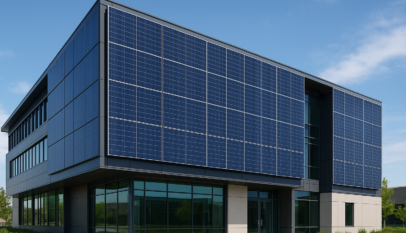
Building integrated photovoltaics BIPV are solar power systems that are fully integrated into the structure of a building, such as roofs, façades, or windows, serving both as functional building materials and sources of renewable energy. BIPV systems generate electricity while replacing conventional building components, making them a seamless part of the building envelope.
Unlike traditional solar panels that are added onto buildings, BIPV products provide structural benefits, contributing to the building’s architecture and reducing the need for separate materials. This dual-purpose approach improves energy efficiency and can support sustainable design without compromising aesthetics.
The use of BIPV is growing as innovations in materials and design broaden its applications, helping buildings become more energy-conscious and environmentally friendly. It offers a practical solution for cities aiming to blend clean energy generation with modern architecture.
Overview of Building Integrated Photovoltaics (BIPV)
Building Integrated Photovoltaics (BIPV) are solar technologies that merge energy generation with building materials. They replace traditional construction elements while producing electricity. Understanding the structure and how BIPV differ from standard solar panels clarifies their role in modern architecture.
What Are BIPV Systems?
BIPV systems integrate photovoltaic materials directly into building components such as roofs, facades, and windows. Unlike add-on solar panels, these systems serve dual purposes: structural functions and power generation.
They can replace conventional materials like roofing tiles or curtain walls. This integration helps reduce overall material costs and improves building aesthetics.
BIPV technologies include semi-transparent solar cells, bifacial modules, and thin-film options. These variations allow flexible design choices while meeting energy needs.
Additionally, BIPV supports energy efficiency by generating renewable power on-site, reducing dependence on external grids.
Comparison to Conventional Solar Panels
Conventional solar panels are typically mounted onto existing building surfaces without replacing structural elements. These systems are added after construction and focus solely on power generation.
In contrast, BIPV replaces or forms part of the building envelope, combining functionality with design. This integration can decrease installation time and material costs.
Conventional panels are often visibly mounted, which can affect building aesthetics. BIPV offers a seamless look, blending into architectural features.
However, BIPV may come with higher upfront design and manufacturing complexity. The energy output of BIPV can also vary depending on the materials and integration method used.
Applications and Architectural Integration
Building-integrated photovoltaics (BIPV) are incorporated directly into building elements, serving both functional and aesthetic roles. These systems are applied in various architectural components, enhancing energy generation without compromising design. Their integration impacts not only the exterior appearance but also the building’s energy performance.
Building Facades and Curtain Walls
BIPV solutions for facades and curtain walls transform building exteriors into active energy generators. Panels can be customized to fit vertical or angled surfaces, often replacing conventional cladding materials. This dual-purpose use maintains architectural integrity while adding renewable energy capabilities.
Semi-transparent photovoltaic modules are common, allowing natural light penetration without sacrificing energy capture. They also contribute to shading, reducing interior heat gain and lowering cooling loads. Facade BIPV can be configured in different colors and finishes, supporting creative architectural expression.
Installation on curtain walls requires consideration of structural support and electrical connections. These systems integrate seamlessly with glazing and framing, making them suitable for commercial high-rises and modern buildings that prioritize sustainability.
Rooftop and Skylight Implementations
Roofs and skylights are prime locations for BIPV due to maximum solar exposure. Photovoltaic materials can replace traditional roofing components, such as shingles, tiles, or glass panels, maintaining waterproofing and insulation functions.
For skylights, semi-transparent BIPV modules generate electricity while admitting daylight, enhancing interior illumination. This reduces reliance on artificial lighting during the day. Roof-mounted BIPV systems are often designed to match the roof’s form and material, preserving architectural design.
Careful orientation and tilt of rooftop BIPV optimize energy yield. Integration with existing roofing materials involves ensuring weather resistance and minimizing penetrations, which reduces maintenance needs. These installations suit both new builds and retrofits.
Energy Performance Benefits
BIPV systems contribute to improved building energy efficiency by offsetting grid electricity consumption. They reduce operational costs and decrease carbon emissions from buildings. Since BIPV modules are part of the envelope, losses from separate mounting structures are minimized.
By integrating shading functions, BIPV also moderates internal temperatures. This “passive cooling” effect lowers the demand for HVAC systems. In some cases, bifacial modules capture reflected light from surrounding surfaces, further improving energy generation.
Monitoring and control systems are often included to optimize performance. This integration supports real-time management of energy flow, enhancing reliability and return on investment.
British Virgin Islands Company Registration Guide for Seamless Offshore Setup
Registering a company in the British Virgin Islands (BVI) is a straightforward process tha…









